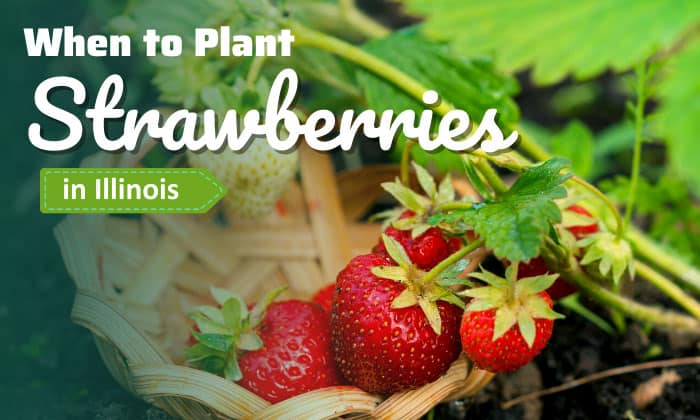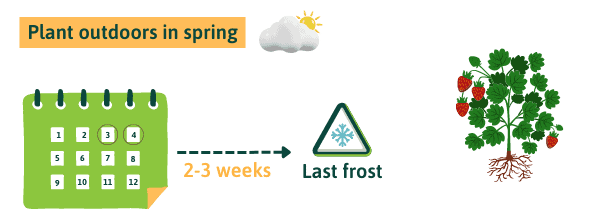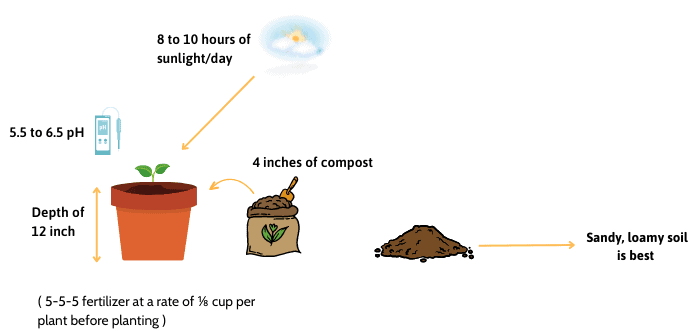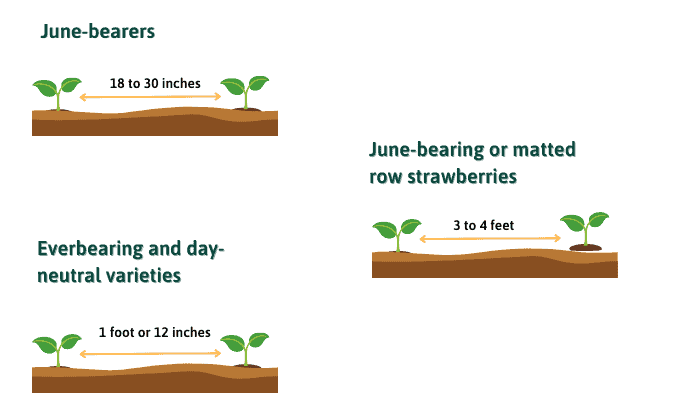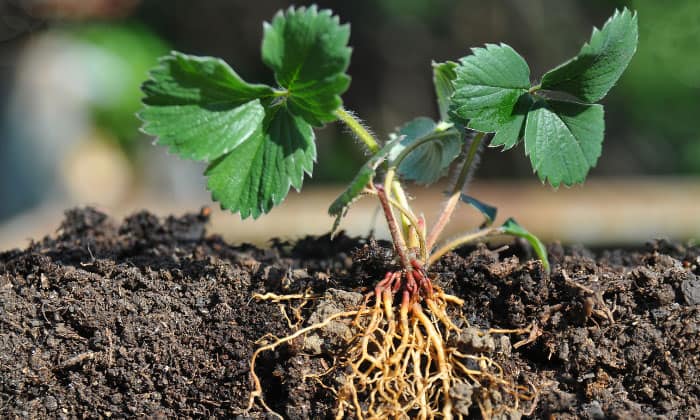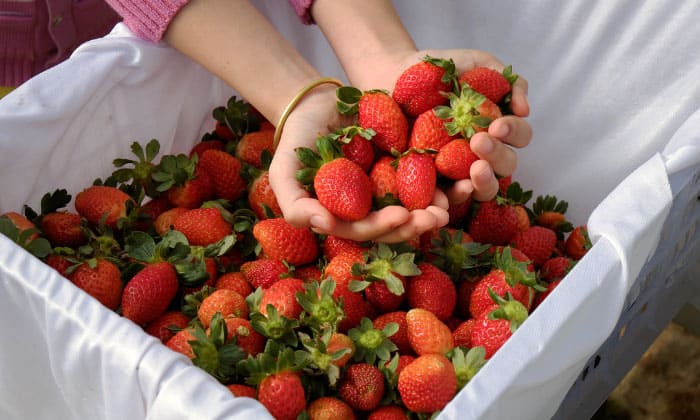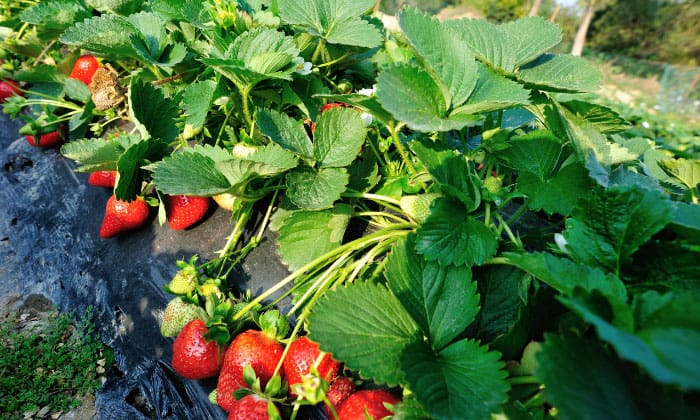Strawberries make for delightful summer snacks, whether we put them in cakes, sangrias, or popsicles. If you’re growing strawberries in Illinois, March and April are the best months for planting, though it’s possible to sow these fruits around the first week of May for a July to October harvest.
Learn when to plant strawberries in Illinois by reading below.
Table of Contents
Best Time to Plant Strawberries in Illinois
1. Plant outdoors in spring in March and April.
The best time for planting strawberry crops in Illinois is March and April, around two to three weeks before the last frost in spring when the ground is warm and workable.
You don’t have to worry much about frost damage during this time, but it may be safer to cover the strawberries with cloth in case an extreme freeze is expected. Strawberries will grow outdoors in early spring under this time frame and form roots to prepare themselves for winter.
Here are the estimated planting dates for different locations in Illinois.
| Location | Final frost | Start of growing season |
| Alton | April 9 | March 19 |
| Belleville | April 19 | March 29 |
| Chicago | April 17 | March 27 |
| Danville | April 27 | April 6 |
| Freeport | May 2 | April 11 |
2. Plant strawberries indoors.
Planting strawberries indoors is unnecessary, considering seeds have lower viability than transplants. But if you want to use strawberry seeds, grow strawberries in pots indoors six to eight weeks before the last frost at a depth of ¼ inch and keep them in a room with temperatures of 60-70°F.
Once the plant size is two to three inches in height and there are two sets of true leaves, you can move them outdoors. Just make sure there is no frost first and to harden off the seedlings beforehand.
In any case, you can check out the planting time for different Illinois regions below.
3. Planting time for different areas
| Area | Last frost (average) | Plant indoors | Plant outdoors |
| Northern Illinois (zone 5a) | May 1 – May 10 | March 6 – March 15 | April 10 – April 19 |
| Central Illinois (zone 5b and 6a) | April 11 – April 30 | February 14 – March 5 | March 21 – April 9 |
| Southern Illinois (zone 6a to 7a) | April 1 – April 10 | February 4 – February 13 | March 11 – March 20 |
4. Is it too late to plant strawberries in Illinois?
One can grow strawberries in Illinois as late as May. In this case, opt for bare-root day-neutral varieties for straberry cultivation and treat them as annuals. You can put the crops in a plasticulture system if you want, but it’s not mandatory.
Remove all runners during the first six weeks, after which flowers will appear and you can expect fruiting to begin in July until October.
Another option for late planting is to grow berries in a greenhouse, which will allow for year-round cultivation regardless of where you are.
Strawberry Growing Process
1. Soil preparation
Remove weeds and loosen the soil with a hoe down to a depth of twelve inches. Work four inches of compost into the ground and ensure the pH is 5.5 to 6.5 for optimal growth.
You can also apply a 5-5-5 fertilizer at a rate of ⅛ cup per plant before planting.
As for where to plant strawberries, a location with eight to ten hours of sunlight per day and sandy, loamy soil is best.
2. Selecting strawberry varieties
June-bearing, everbearing, and day-neutral strawberries can all grow in Illinois.
However, of these different kinds of strawberries, June bearers will have the best taste with the biggest size.
Day-neutral and everbearing varieties are more suitable for growers with little gardening space and a hill planting system, whereas June-bearing strawberries complement matted rows the best.
Which type you choose ultimately depends on your circumstances and preference. For reference, here are some strawberry varieties that adapt to Illinois’ climate well.
| Category | Cultivar | Note |
| June-bearing | Earliglow | Resistant to red stele root rot and verticillium wilt. Suitable for both garden beds and containers. |
| Delmarvel | Resistant to root rot and most stem diseases. Firm and tasty when eaten fresh or preserved. | |
| Jewel | Resistant to cold temperatures, but susceptible to red stele disease. Excellent in pies and jams. | |
| Allstar | Resistant to red stele root rot and powdery mildew. Glossy and very sweet. | |
| Day-neutral | Tristar | Resistant to red stele root rot and verticillium wilt. Produces sizable fruits that look beautiful in hanging baskets. |
| Tribute | Resistant to leaf scorch and verticillium wilt. Tart strawberries that suit baking and fresh consumption. | |
| Everbearing | Albion | Small strawberries that resist anthracnose and crown rot. For both fresh consumption and processing.
|
3. Planting technique, spacing, and depth
You can gauge the minimum soil depth for strawberries by sowing them. Ensure the roots are covered but the crown is slightly above-ground to minimize risks of disease.
The planting spacing for strawberries will differ for June bearing vs everbearing strawberries and day-neutral types. June-bearers should be 18 to 30 inches apart, while everbearing and day-neutral varieties only require 1 foot or 12 inches of distance between plants.
At the same time, June-bearing or matted row strawberries should have rows that are 3 to 4 feet apart, but 2 feet will suffice for the hill planting system if you grow crops this way.
Other tips for successful gardening are:
- Strawberries need an inch of water per week, and it’s best to irrigate them in the morning with drip lines to ensure maximum moisture absorption.
- Protect your plants from winter temperatures of 20 degrees Fahrenheit using old sheets or Reemay. We also recommend mulching the ground with three to four inches of straw when you grow strawberries in rows.
This will protect the roots and crown from freezing weather and stave off weeds.
- Remove some of the mulch for strawberries in the spring when there’s new growth on the plants.
Maintenance and Ongoing Care
Immediately remove flowers on June-bearing strawberries during the first year so that next year’s yield will be higher in quality and quantity.
For growers with day-neutral and everbearing plants instead, cut away blossoms that appear in June and earlier. All flowers that grow after should be left intact for future fruit production.
Note that after harvesting is complete, you should cut the plants so that only two inches of the stem remain above the crown.
It’s also advisable to perform a soil test and fertilize your strawberry patch according to its recommendation, but if not, one pound of a 10-10-10 per 100 feet usually suffices.
As the seasons progress, remember to rotate your crops between different garden beds every three years.
Harvesting Strawberries in Illinois
Strawberries are often harvestable in Illinois from April to June. You can grow multiple cultivars to collect different batches of June strawberries, or visit U-pick farms for a bigger share of the fruit.
Before picking, check if the berries are firm, evenly red, and blemish-free. Fruits with green or white spots are not ripe yet, so you should leave them on the vines a bit longer.
To collect strawberries, twist them off at the stem without removing the cap. Store the fruits in the fridge until you’re ready to wash and eat them. Do not run the fruits under water if you plan to keep them for longer.
Frequently Asked Questions
When do everbearing strawberries produce fruit?
Everbearing strawberries grow fruits in the spring, summer, and fall until frost arrives. They can bear fruits in the first year of planting, unlike June-bearers, whose production is often delayed on purpose until the second year.
However, everbearing strawberries will need at least twelve hours of day length to be productive, and temperatures above 75 degrees can reduce their yield. After the second year, it is advisable to replace these plants with new ones.
What do strawberries need to grow?
Strawberry soil requirements are a pH of 5.5 to 6.5, with adequate drainage and full sun. If grown in containers, they need peat-free compost and a potassium liquid feed every two weeks during the planting season.
Strawberry growing conditions temperature is 50 to 80℉ for fruit production and no less than 20 degrees during winter once they’ve become established.
Do strawberries grow well in Illinois?
Yes. They do grow well in Illinois. You can find plenty of farms that offer strawberries for picking every year.
Can you grow strawberries from fruit?
No. You can’t propagate strawberries using the fruits themselves. What works is using the seeds or bare-root plants, though seeds have lower rates of success.
Conclusion
We hope this article gave you useful information on when to plant strawberries in Illinois. With the right variety and sufficient care, it won’t be hard to produce fresh, scrumptious strawberries right in your backyard. Have fun gardening, and leave us a message to share your thoughts.
Read more: Best time to Plant Strawberries in Georgia, Tennessee, Zone 7,…

Hi, I am William – Floridayards’ digital content creator. My job is to find answers to all your concerns with thorough research and our team’s expert advice. I will also bring you honest reviews on the best products and equipment for raising your beautiful garden. Please look forward to our work!


